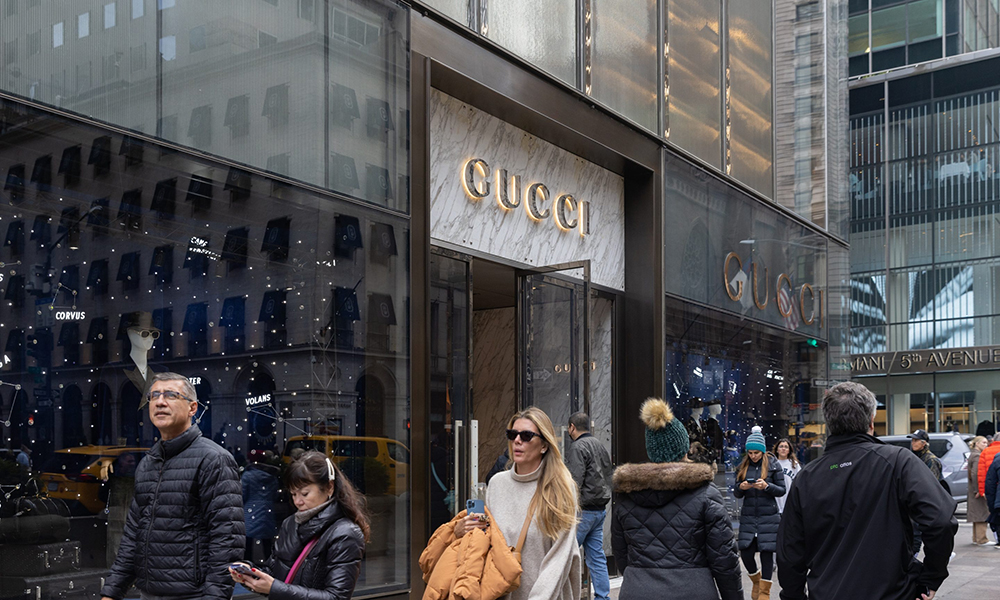
前幾個奢侈品行業的慘淡行情讓不少人質疑美國“繁榮的20年代”是否已經結束了。但實際上,前幾年奢侈品行業的異常繁榮,很大程度上是因為疫情期間,人們出不了門,消費欲無處發泄,便瘋狂網購昂貴的衣服、鞋包等等,從而導致了奢侈品銷量的飆升。現在,各大奢侈品品牌都面臨著銷量下滑的局面,但也有幾個品牌卻準備在世界頂級的購物中心里擴大自己的零售面積。
比如,法國開云集團在本周一表示,將投資9.63億美元于紐約市的高端地產。開云集團旗下擁有古馳(Gucci)、圣羅蘭(Saint Laurent)和巴黎世家(Balenciaga)等知名奢侈品品牌。
開云集團在聲明中稱:“通過這筆交易,開云集團在世界上最具標志性的街道上獲得了絕佳的零售地點。這筆投資代表著開云集團的精選地產戰略邁出了新的一步,我們的目標就是確保零售店的絕佳地段。”
這處地產占地約10700平方米,坐落于曼哈頓著名的第五大道,對面就是特朗普大廈,附近還有卡地亞(Cartier)、路易威登(Louis Vuitton)和蒂芙尼(Tiffany & Co)等高端奢侈品品牌的門店。
近年來,開云集團還在巴黎和東京等地買下了幾處黃金地段。
無獨有偶
除了開云集團,其他一些奢侈品品牌也正在全美各大城市搶占零售地產。比如歷峰集團旗下的珠寶品牌梵克雅寶表示,將在曼哈頓的麥迪遜大道開設新門店。而香奈兒(Chanel)在洛杉磯比佛利山的旗艦店也將重新開張。另據彭博社報道,普拉達(Prada)上個月也進行了兩筆總價值8.35億美元的地產投資。
開云集團拒絕就這筆房地產收購交易發表評論。
實際上,各大奢侈品零售商都在以驚人的速度搶購地產。據房地產投資公司JJL的一份報告顯示,從2022年9月到2023年9月,各大奢侈品品牌在美國一共租賃了65萬平方英尺的零售面積,較上年同期增長了大約160%。
這些品牌也并不是在盲目地進行地產投資。畢竟隨著疫情過去,人們會逐步回到實體店,來解決網購以外的消費需求。穆迪公司的一位高級經濟學家本月初向《財富》表示,盡管其他行業仍在復蘇路上,但是美國的商業地產2024年肯定會保持“穩健”。
收入下滑
就在這些奢侈品公司大肆在地產市場上“買買買”之際,奢侈品的消費者們卻已經收緊了荷包,導致不少奢侈品牌的銷量都受到了影響。比如開云集團第三季度的可比營收下降了9%,特別是古馳和伊夫圣羅蘭這兩個品牌的銷量下跌明顯。
可以肯定的是,美國市場一直是部分奢侈品品牌的亮點,而歐洲市場卻已經難以復刻早些年的繁榮時光。以歷峰集團為例,其美洲市場(包括北美和南美)2023年第三季度的銷售額同比增長了8%。而與之形成鮮明對比的是,同一時期歐洲市場的銷量則下滑了3%。
不過這種趨勢也并非普遍現象。比如路威酩軒集團旗下的化妝品連鎖零售品牌絲芙蘭(Sephora)今年第三季度在北美市場呈現強勢增長。但與此同時,該集團旗下的葡萄酒、洋酒、皮具和時尚產品等則顯得相對疲軟。縱向相比,英國的風衣品牌巴寶莉(Burberry)第三季度在美洲的同店銷售額降幅最大。
從這些或好或壞的跡象看,它們總的來說預示著市場增長放緩,而另一方面也預示著中國的奢侈品需求或將復蘇,而這可能會對奢侈品的銷量產生刺激作用。奢侈品行業領頭羊路威酩軒集團將于本周四發布財報,這份財報或將暗示2024年整個行業的行情走向。(財富中文網)
譯者:樸成奎
前幾個奢侈品行業的慘淡行情讓不少人質疑美國“繁榮的20年代”是否已經結束了。但實際上,前幾年奢侈品行業的異常繁榮,很大程度上是因為疫情期間,人們出不了門,消費欲無處發泄,便瘋狂網購昂貴的衣服、鞋包等等,從而導致了奢侈品銷量的飆升。現在,各大奢侈品品牌都面臨著銷量下滑的局面,但也有幾個品牌卻準備在世界頂級的購物中心里擴大自己的零售面積。
比如,法國開云集團在本周一表示,將投資9.63億美元于紐約市的高端地產。開云集團旗下擁有古馳(Gucci)、圣羅蘭(Saint Laurent)和巴黎世家(Balenciaga)等知名奢侈品品牌。
開云集團在聲明中稱:“通過這筆交易,開云集團在世界上最具標志性的街道上獲得了絕佳的零售地點。這筆投資代表著開云集團的精選地產戰略邁出了新的一步,我們的目標就是確保零售店的絕佳地段。”
這處地產占地約10700平方米,坐落于曼哈頓著名的第五大道,對面就是特朗普大廈,附近還有卡地亞(Cartier)、路易威登(Louis Vuitton)和蒂芙尼(Tiffany & Co)等高端奢侈品品牌的門店。
近年來,開云集團還在巴黎和東京等地買下了幾處黃金地段。
無獨有偶
除了開云集團,其他一些奢侈品品牌也正在全美各大城市搶占零售地產。比如歷峰集團旗下的珠寶品牌梵克雅寶表示,將在曼哈頓的麥迪遜大道開設新門店。而香奈兒(Chanel)在洛杉磯比佛利山的旗艦店也將重新開張。另據彭博社報道,普拉達(Prada)上個月也進行了兩筆總價值8.35億美元的地產投資。
開云集團拒絕就這筆房地產收購交易發表評論。
實際上,各大奢侈品零售商都在以驚人的速度搶購地產。據房地產投資公司JJL的一份報告顯示,從2022年9月到2023年9月,各大奢侈品品牌在美國一共租賃了65萬平方英尺的零售面積,較上年同期增長了大約160%。
這些品牌也并不是在盲目地進行地產投資。畢竟隨著疫情過去,人們會逐步回到實體店,來解決網購以外的消費需求。穆迪公司的一位高級經濟學家本月初向《財富》表示,盡管其他行業仍在復蘇路上,但是美國的商業地產2024年肯定會保持“穩健”。
收入下滑
就在這些奢侈品公司大肆在地產市場上“買買買”之際,奢侈品的消費者們卻已經收緊了荷包,導致不少奢侈品牌的銷量都受到了影響。比如開云集團第三季度的可比營收下降了9%,特別是古馳和伊夫圣羅蘭這兩個品牌的銷量下跌明顯。
可以肯定的是,美國市場一直是部分奢侈品品牌的亮點,而歐洲市場卻已經難以復刻早些年的繁榮時光。以歷峰集團為例,其美洲市場(包括北美和南美)2023年第三季度的銷售額同比增長了8%。而與之形成鮮明對比的是,同一時期歐洲市場的銷量則下滑了3%。
不過這種趨勢也并非普遍現象。比如路威酩軒集團旗下的化妝品連鎖零售品牌絲芙蘭(Sephora)今年第三季度在北美市場呈現強勢增長。但與此同時,該集團旗下的葡萄酒、洋酒、皮具和時尚產品等則顯得相對疲軟。縱向相比,英國的風衣品牌巴寶莉(Burberry)第三季度在美洲的同店銷售額降幅最大。
從這些或好或壞的跡象看,它們總的來說預示著市場增長放緩,而另一方面也預示著中國的奢侈品需求或將復蘇,而這可能會對奢侈品的銷量產生刺激作用。奢侈品行業領頭羊路威酩軒集團將于本周四發布財報,這份財報或將暗示2024年整個行業的行情走向。(財富中文網)
譯者:樸成奎
The luxury industry’s rocky road over the past few months has prompted questions about the end of the “roaring 20s”—the period during the COVID-19 pandemic when sales skyrocketed, thanks to homebound shoppers splurging on expensive clothes, handbags, and more. But some while luxury brands navigate a slowdown, others are simultaneously gearing up to grow their retail space in the world’s top shopping hubs.
French group Kering, the brand behind luxury houses like Gucci, Saint Laurent and Balenciaga, is investing a whopping $963 million in prime New York City property, the company said in a press release Monday.
“With this transaction, Kering acquires exceptional retail locations on one of the world’s most iconic avenues,” Kering said in the statement. “This investment represents a further step in Kering’s selective real estate strategy, aimed at securing key highly desirable locations for its Houses.”
The property will span 115,000 square feet (10,700 square meters), and will be located on Manhattan’s famed Fifth Avenue, across from Trump Tower. Some of the other high-end retailers located in the vicinity include Cartier, Louis Vuitton, and Tiffany & Co.
The Fran?ois-Henri Pinault–led company has also purchased other key properties in Paris and Tokyo in recent years.
Kering not alone
Kering is joining some of its luxury rivals in grabbing retail property in New York and elsewhere in the U.S.—jeweler Van Cleef & Arpels (owned by Richemont) said it was opening new locations on Manhattan’s Madison Avenue, while Chanel reopened its flagship store in the upmarket Los Angeles area of Beverly Hills. And Prada made two purchases worth $835 million combined last month, Bloomberg reported.
Kering declined to comment on the new real estate acquisition.
Indeed, luxury retailers are snapping up property at stunning rates—they’ve leased 650,000 square feet of space in the U.S. in the 12 months to September, marking a roughly 160% increase compared with a year earlier, according to a report by real estate investment firm JLL.
The bet on retail real estate could potentially pay off as people come back to physical stores to supplement their shopping needs alongside buying online. Retail properties promise to be a “stalwart” through 2024, a senior Moody’s economist told Fortune earlier this month, even as other sectors continue to recover.
Revenue slump
These big purchases by luxury players come at a time when the industry is seeing its wealthy customers pull back on spending, the impact of which has trickled down to the sales of these brands. Kering’s revenue was down 9% on a comparable basis for the third quarter, with contractions in Gucci and Yves Saint Laurent sales.
To be sure, the U.S. has been a bright spot for some brands, as Europe struggles to clock in sales like it did in earlier years. Take Richemont, for instance—sales in the Americas region (which includes North and South America) saw 8% growth in the third quarter of 2023, compared with the same time a year earlier. That’s in contrast with a 3% decline in Europe for that period.
The trend isn’t universal, though. Makeup chain Sephora, owned by LVMH, saw strong growth in North America in the third quarter, although demand for the French conglomerate’s wine and spirits as well as fashion and leather goods segments remained weak through the first half of last year. British trench-coat maker Burberry also saw comparable store sales in its third quarter decline the most in the Americas compared with the same time in 2022.
The signs are mixed in the luxury space as they point to a slowing pace of growth while also hinting at a revival of Chinese luxury demand—which could fuel sales. Luxury bellwether LVMH is set to release results Thursday, which could indicate the path forward for the rest of the industry as 2024 unfolds.






